Why Does My Older Child Chew on Everything?
Posted by Debra C. Lowsky, MS, CCC-SLP on 29th Nov 2015
Question: My 9 year old chews on everything... erasers, foam rubber, shirt collars. He has always had an oral fixation since he was a toddler, putting toys in his mouth and chewing on everything in sight. Is this something more than typical childhood behavior? I've read on some discussion boards that your "Grabbers" are often used by other kids with the same issue. Looking for advice...
.
Great question. For babies and toddlers, putting things in their mouths is a normal stage of oral development. .
Some children, however, continue to chew non-food items well past the mouthing/teething stage. For some, it is a passing phase. Other individuals will always have a need to chew that may continue into adulthood.
.
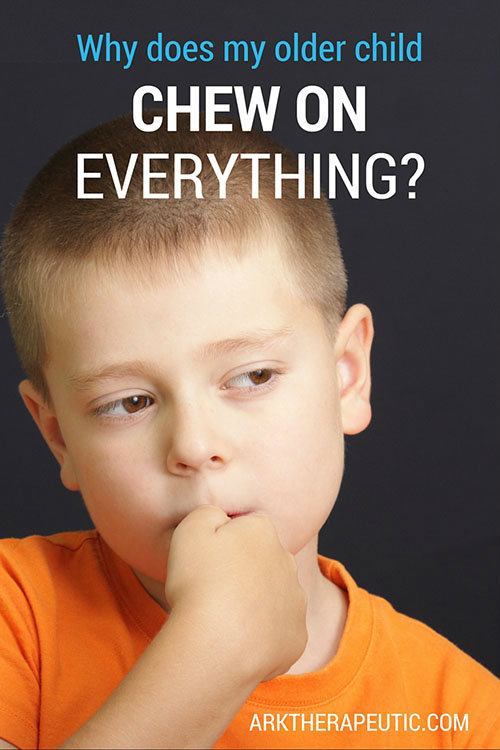
.
Why? There could be many different reasons, and it’s not always a straight answer. But in my personal experience with the children I see in therapy, it’s typically one (or a combination of) the following:
.
STRESS / ANXIETY
The most common explanation for why some children chew is because of stress and/or anxiety. Chewing provides proprioceptive input to the jaw that is very calming and organizing. It’s similar to how some people might bite their fingernails when they’re nervous, or pace back and forth, do deep breathing, tap their foot, etc. It also harkens back to how mouthing/chewing/sucking is a self-soothing technique when we’re babies. These are all mechanisms for how we cope with stress.
The stress we’re talking about could be everyday stress - when kids are frustrated, mad, or tired. Or, it could be the added anxiety of going to a new place, starting school again, etc. Chewing will typically increase relative to the amount of stress, AND relative to how well children deal with stress.
Chewing is an easy way for kiddos to calm themselves because:
1. It’s a known motor plan.
2. There is always something nearby that they can chew on (whether or not it’s safe/appropriate) - a shirt, pencil, toy, something picked up off the floor, etc.
3. They can also control what goes in their mouth, which is something that many kids don't get to do very often.
.
SENSORY NEEDS / STIMMING
Chewing as a calming mechanism is especially true for children who have Autism and/or sensory processing disorder (SPD).
Individuals with sensory issues process the world differently, and oftentimes it can be very overwhelming. Lights might be brighter. Sounds might be louder. Touch might be painful. And so forth.
Short for self-stimulation, stimming is one way that individuals with sensory issues organize themselves and manage all of the extra sensory information bombarding their systems. Stimming is typically anything repetitive, such as flapping one’s hands, rocking back and forth, spinning things, repeating certain words, chewing, etc.
.
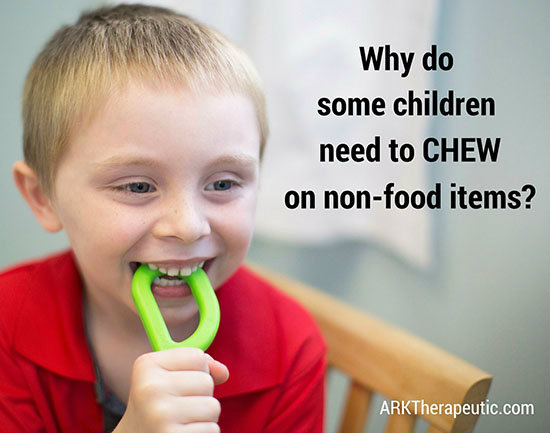
.
BODY AWARENESS / PROPRIOCEPTION
We process the world around us through our senses, one of which is the lesser known “sixth sense” called proprioception. In short, proprioception is our ability to know where our body is in time and space. It’s how we process input from our joints and muscles in order to move and position the body.
When children have difficulties properly interpreting this information, it can pose a whole host of problems. You might see them crashing into things, have poor motor control, have the “wiggles” and not be able to sit still or focus, and/or many other things.
These kids in particular require what’s called a “sensory diet” of activities to regulate their systems. This is something an occupational therapist puts together. It’s catered to each child depending on their needs, and typically includes some sort of heavy work activities. If there isn’t a sensory diet in place, or if for some reason they’re not getting the right amount of compensatory proprioceptive input at any point throughout the day, they may try to self-regulate on their own. And oftentimes they do this through chewing because again, it’s something that they know, have access to, and can control, and it provides proprioceptive input to the jaw.
.
ORAL AWARENESS
Some individuals have what’s called “oral hyposensitivity,” which is a fancy way of saying they have limited to no sensation in their mouths.
To use a comparison that’s probably more relatable, imagine that for some reason you have decreased sensation in your fingers. How would you compensate? You would probably press on things harder, grip things tighter, maybe seek out things that are textured and have a lot of tactile information to them, and so forth.
Similarly, individuals with limited oral awareness may seek out activities that provide increased oral feedback, such as eating crunchy foods, stuffing their mouths with food, grinding their teeth, and/or (you guessed it) chewing on non-food items. It is possible, however, to “wake up” the mouth and increase sensation. For more information, click here.
.
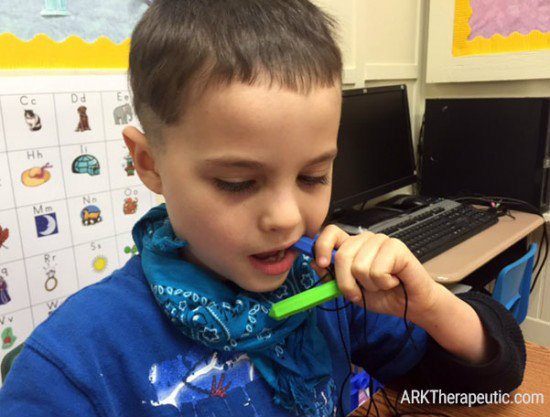
.
CONCENTRATION
Have you ever chewed gum during a test? Or chewed on a pen cap or pencil while trying to concentrate on something? If not, then odds are you know someone who did/does. This is because chewing can be a very effective way to increase focus and block out other distractions, especially since it’s a repetitive movement. Chewing also activates muscles in the jaw down into the neck, which provides added stability that is grounding, particularly for children with decreased motor planning.
.
PICA
Pica is characterized by the need/craving to not just chew, but eat non-food items (paper, clay, sand, etc.). If you suspect this is why your child is chewing, please seek medical help right away.
.
TEETHING
It’s not uncommon to see children chew for relief when their 6 year molars start to erupt. If this is the cause, it will likely pass when the teeth are done moving into place.
.
G-TUBE
When individuals can’t eat by mouth, they may still crave or miss the act of chewing. Let them satisfy that need by chewing on a chew tool during tube feedings.
.
BOREDOM / HABIT
We all have our habits. And again, if a child is bored, there is always something nearby that could potentially be chewed on, whether or not it’s safe.
.
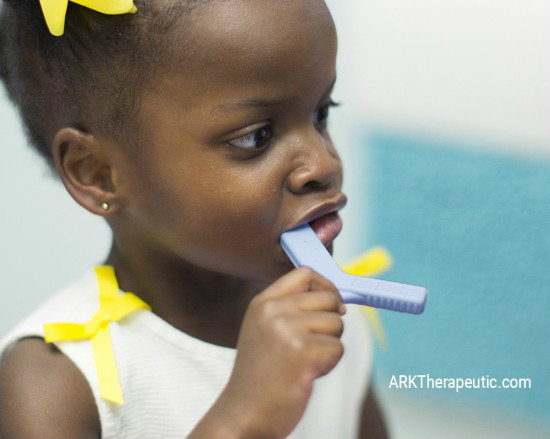
.
What can you do to help?
Remember - it's not that they WANT to chew, it's that they NEED to chew. Although sometimes biting/chewing can be behavioral, in my experience it is most often sensory-related. In which case telling them to stop is not going to work. For one reason or another, their body is telling them that they need to chew, and they're adeptly listening.
You can make sure they do this safely by giving them a proper outlet to chew on. The Grabber you mentioned was created specifically for this purpose. We also make a similar Y-shaped one called the Y-Chew, chewable pencil toppers for an easy way to chew while writing, and wearable “chewelry” (chewable jewelry) for discreet on-the-go oral sensory input. Each of these comes in 3 color-coded toughness levels:
.
• Standard/Soft - this is the softest level, recommended for mild chewers (who don't usually chew through things).
• XT/Medium Firm - XT stands for "Xtra Tough." This level is firmer yet still fairly chewy, recommended for moderate chewing (this is a longer lasting option for those who can eventually chew through items)
• XXT/Super Firm - XXT stands for "Xtra Xtra Tough." This level is the most firm, recommended for individuals with heavy oral sensory needs who can chew through the XT level and/or other tough items (like legos, wooden items, etc.) quickly.
.
Several shapes are long and slender enough to reach the back molar area - this is where chewing is typically needed the most because it provides the most proprioceptive input to the jaw. And all of our chews are also made in the USA (specifically, made by my husband and son under our own roof here in Columbia, South Carolina).
For help picking the right one(s), see this Chew Chart and/or Chewing Guide to narrow down the options. Please also feel free to email us for specific recommendations. See past recommendations here.
.
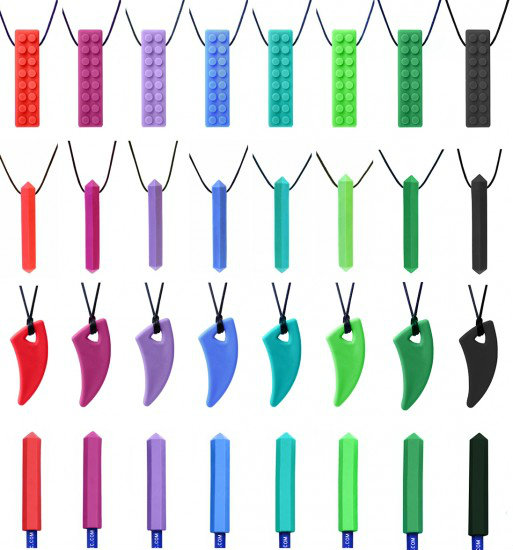
.
For some individuals, that may be all that's needed - just some oral motor input from time to time to regulate, calm, and focus.
For others, a chew tool alone may not be enough, particularly if the chewing is aggressive and/or overwhelming. You may need to consult with the child's pediatrician for additional support. And particularly when the chewing is sensory-related, an occupational therapist (OT) can help put together a sensory diet of additional strategies.
For more oral sensory strategies and advice for those who need to chew, click here.
.
All my best,
Debbie
Debra C. Lowsky, MS, CCC-SLP
.
